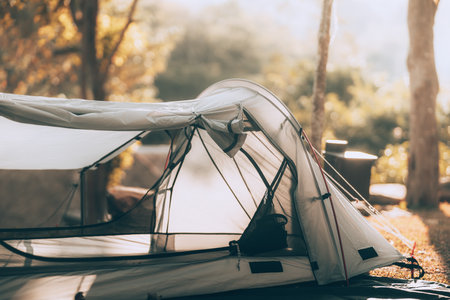1. Remote Wilderness Areas
If youre looking to push your survival skills to the limit, remote wilderness areas in the U.S. offer some of the most rugged and untouched landscapes you can find. These locations are perfect for survivalist camping because they strip away modern conveniences and challenge your ability to live off the land.
Alaskas Interior
One of the most isolated regions in North America, Alaska’s Interior is a vast expanse of tundra, boreal forest, and mountains. With few roads and even fewer people, its a place where self-reliance isn’t just an option—it’s a necessity. This area is ideal for experienced campers who want to practice bushcraft, navigation, and wildlife awareness in a truly wild environment.
Bob Marshall Wilderness, Montana
Known simply as “The Bob,” this 1.5-million-acre wilderness area is one of the largest roadless areas in the lower 48 states. It features rugged terrain, dense forests, alpine lakes, and plenty of wildlife like grizzly bears and mountain goats. No motorized vehicles or bikes are allowed here, making it a true backcountry experience for those looking to master long-distance hiking and survival techniques.
Why Choose Remote Wilderness Areas?
| Feature | Benefit for Survivalists |
|---|---|
| No Cell Service | Forces you to rely on maps, compasses, and survival knowledge |
| Diverse Terrain | Allows practice in various survival scenarios—from mountains to forests |
| Limited Access | Keeps crowds away and enhances solitude for true self-reliance |
Quick Tips for Remote Camping
- Always let someone know your itinerary before heading out
- Carry a reliable satellite communication device for emergencies
- Brush up on local wildlife behavior and safety practices
- Pack light but include essential gear like water purification tools, fire starters, and a sturdy knife
2. Desert Survival Campsites
If youre looking to test your survival skills in one of the most unforgiving environments, desert camping might be for you. The American Southwest is home to some of the most iconic desert landscapes, where temperatures swing drastically between day and night, water is scarce, and navigation can be tricky. Places like Utah’s Canyonlands National Park and Arizona’s Sonoran Desert offer a raw and rugged experience for any survivalist camper.
Top Desert Survival Locations
| Location | State | Key Challenges | Survival Skills Needed |
|---|---|---|---|
| Canyonlands National Park | Utah | Extreme heat, limited water sources, rough terrain | Water purification, sun protection, map reading |
| Sonoran Desert | Arizona | Wildlife encounters, dehydration risk, harsh sunlight | First aid, hydration strategy, shelter building |
| Mojave National Preserve | California | Sparse vegetation, high temperatures, isolation | Navigation, rationing resources, emergency signaling |
What Makes Desert Camping Unique?
Unlike forest or mountain survival campsites, desert environments demand a different mindset and gear setup. You’ll need lightweight clothing that still offers sun protection, ample water storage options, and a strong understanding of how to find or conserve water. The landscape may look barren, but it’s full of hidden dangers and rewards.
Essential Gear for Desert Survival Camping:
- High-capacity hydration packs or water bladders
- UV-protective clothing and wide-brimmed hats
- Portable shade or tarp shelters
- Topographic maps and GPS devices (signal can be spotty)
- A multi-tool or survival knife for various tasks
- Sunscreen with high SPF and lip balm with UV protection
Tips for First-Time Desert Survivalists
If it’s your first time heading into the desert backcountry, start small. Choose areas with designated primitive campsites and reliable trail markings. Always inform someone about your travel plans and expected return time. Avoid hiking during peak heat hours—early morning or late afternoon treks are safer and more enjoyable.
Pro Tip:
Bury your food waste properly and pack out all trash. The desert ecosystem is fragile and takes years to recover from human impact.
The desert might seem inhospitable at first glance, but once you understand its rhythms and respect its limits, it becomes one of the most rewarding places to test your survival abilities.
![]()
3. Mountain Terrain Destinations
If youre looking to take your survivalist camping skills to the next level, heading into mountain terrain is a true test of endurance and self-reliance. The United States is home to some of the most rugged and remote mountain ranges, offering both breathtaking views and serious challenges. Whether its the towering peaks of the Rockies or the dense forests of the Appalachians, these destinations are perfect for campers who want to push their limits.
Why Choose Mountain Terrain?
Mountain regions often come with unpredictable weather, steep elevation changes, and limited access to supplies or help. For survivalist campers, this means every step must be carefully planned—from navigation and gear to food storage and emergency readiness. These environments demand physical stamina, solid map-reading skills, and mental grit.
Top Mountain Survivalist Spots in the U.S.
| Destination | Location | Key Challenges | Best Time to Visit |
|---|---|---|---|
| Rocky Mountain National Park | Colorado | High altitude, sudden snowstorms, wildlife encounters | Late Spring to Early Fall |
| Great Smoky Mountains Backcountry | Tennessee/North Carolina | Dense forests, variable weather, limited visibility | Spring and Fall |
| Sawtooth Wilderness | Idaho | Remote access, rugged trails, cold nights even in summer | Summer |
| White Mountains (Presidential Range) | New Hampshire | Steep ascents, rapid weather shifts, exposed ridgelines | Late Spring through Early Fall |
Essential Skills for Mountain Camping
- Navigation: Always carry a topographic map and compass—GPS signals can be spotty.
- Weather Awareness: Learn how to read cloud patterns and check forecasts before you go.
- Layering Clothing: Temperatures can swing dramatically; dress in moisture-wicking layers.
- Water Sourcing: Know how to locate and purify water from streams or snow melt.
- Ankle Support: Bring sturdy hiking boots with good traction for rocky paths.
Pro Tip:
The higher you go, the thinner the air gets. Acclimate slowly if youre not used to altitude. Stay hydrated and avoid overexertion on your first day at elevation.
Tackling mountain terrain isnt just about surviving—its about thriving in an environment that demands your best. Prepare well and embrace the challenge for an unforgettable wilderness experience.
4. Forested Survival Zones
If youre looking to challenge your survival skills in thick, tree-covered environments, the forests of the United States offer some of the best opportunities. From the lush greenery of the Pacific Northwest to the misty hills of the Great Smoky Mountains, forested zones are perfect for learning how to build fires, construct shelters from natural materials, and forage for wild edibles.
Top Forested Areas for Survivalist Camping
| Location | State(s) | Key Skills to Practice |
|---|---|---|
| Olympic National Forest | Washington | Rain shelter building, fire-starting in wet conditions, plant identification |
| Great Smoky Mountains National Park | Tennessee/North Carolina | Foraging, bear safety, natural navigation |
| White Mountain National Forest | New Hampshire/Maine | Cold-weather survival, water sourcing, improvised tools |
What Makes These Zones Unique?
Forested zones are rich in resources but come with their own set of challenges. Heavy rainfall, dense vegetation, and wildlife encounters require you to be alert and adaptable. Youll learn how to read animal tracks, locate dry wood even after rain, and identify plants that are safe to eat—or ones to avoid.
Shelter Building Tips
- Use fallen branches and large leaves for quick cover.
- Pine needles and moss can act as insulation layers.
- Avoid setting up camp near dead trees or under hanging limbs (widowmakers).
Fire-Starting Techniques in Wet Forests
- Look for dry bark inside fallen logs—it’s often protected from rain.
- Cotton balls with petroleum jelly make excellent fire starters.
- A ferro rod can produce sparks even when damp.
Pro Tip:
If you’re in a national forest or park, always check local regulations. Some areas may have restrictions on open fires or collecting natural materials.
5. Coastal and Island Survival Areas
Looking to challenge your survival skills in a completely different environment? Coastal and island areas offer some of the most unpredictable and demanding conditions in the U.S. Unlike forest or mountain terrains, these locations bring in unique elements like shifting tides, saltwater exposure, sudden storms, and limited freshwater sources.
Outer Banks, North Carolina
This chain of barrier islands is not only scenic but also remote enough to test your adaptability. With strong coastal winds, fast-changing weather, and limited resources, youll need to rely on your ability to find or purify water, secure shelter from the wind, and manage food supplies effectively. Keep an eye on tide schedules—what looks like dry land can flood quickly.
Key Challenges:
- High humidity and salt exposure can affect gear
- Tidal changes impact campsite safety
- Limited natural freshwater sources
San Juan Islands, Washington State
Nestled between mainland Washington and Vancouver Island, the San Juan Islands are ideal for advanced survivalists. The marine climate brings frequent fog, cold temperatures even in summer, and unpredictable weather systems. You’ll also need to be cautious of wildlife like seals and even orcas in nearby waters.
Key Challenges:
- Damp conditions make fire-starting difficult
- Navigating by kayak requires knowledge of tides and currents
- Sourcing potable water is essential
Coastal Survival Tips
| Challenge | Solution |
|---|---|
| Tidal flooding | Select campsites above high tide lines and check local tide charts daily |
| Lack of freshwater | Catch rainwater or use portable desalination devices if near saltwater sources |
| Damp firewood | Carry waterproof fire starters or store dry tinder in sealed containers |
If youre looking for a survivalist experience that goes beyond the woods or mountains, coastal regions like the Outer Banks or the islands off Washington State offer a whole new level of adventure. These destinations will push you to adapt quickly to ever-changing environmental factors—and that’s where true survival skills shine.


